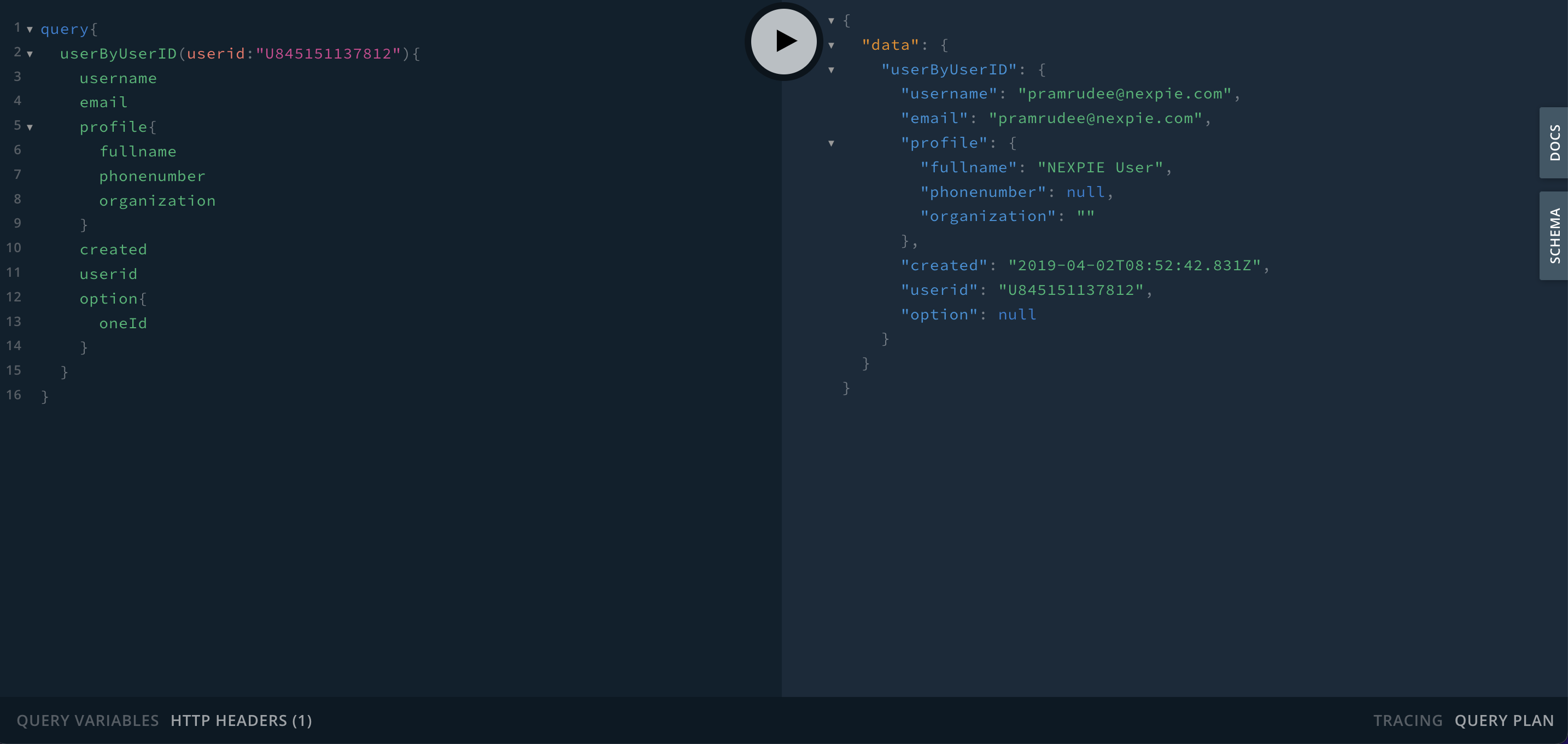QUERIES¶
It will be a function used to retrieve data only. It consists of:
BillingAccountProfile¶
To query Billing Account information (information related to calculation of service volume and charges), each ID has the following details:
BillingAccountProfile ( billingaccountid ):
Arguments
billingaccountid: String is the Billing Account ID (required).
Query Variables
Authorization: User Token
Response Type : BillingAccountProfile
The response is an Object Type BillingAccountProfile consisting of:
billingaccountid: String is the Billing Account ID
name: String is the Billing Account Name
mode: String is the Billing Account Mode
allow_apicall: Boolean is indicator whetherAPI Callare permitted (truefor allowed,falsefor not allowed).
allow_connection: Boolean is indicator whether Connecting a device to the platform are permitted (truefor allowed,falsefor not allowed).
allow_datasource: Boolean is indicator whetherDatasourceare permitted (truefor allowed,falsefor not allowed).
allow_message: Boolean is indicator whetherReal Time Messageare permitted (truefor allowed,falsefor not allowed).
allow_shadowops: Boolean is indicator whetherShadow Read/Write(truefor allowed,falsefor not allowed).
allow_store: Boolean is indicator whetherTime Series Data Storeare permitted (truefor allowed,falsefor not allowed).
allow_trigger: Boolean is indicator whetherTrigger & Actionare permitted (truefor allowed,falsefor not allowed).
An example is shown in the following figure:
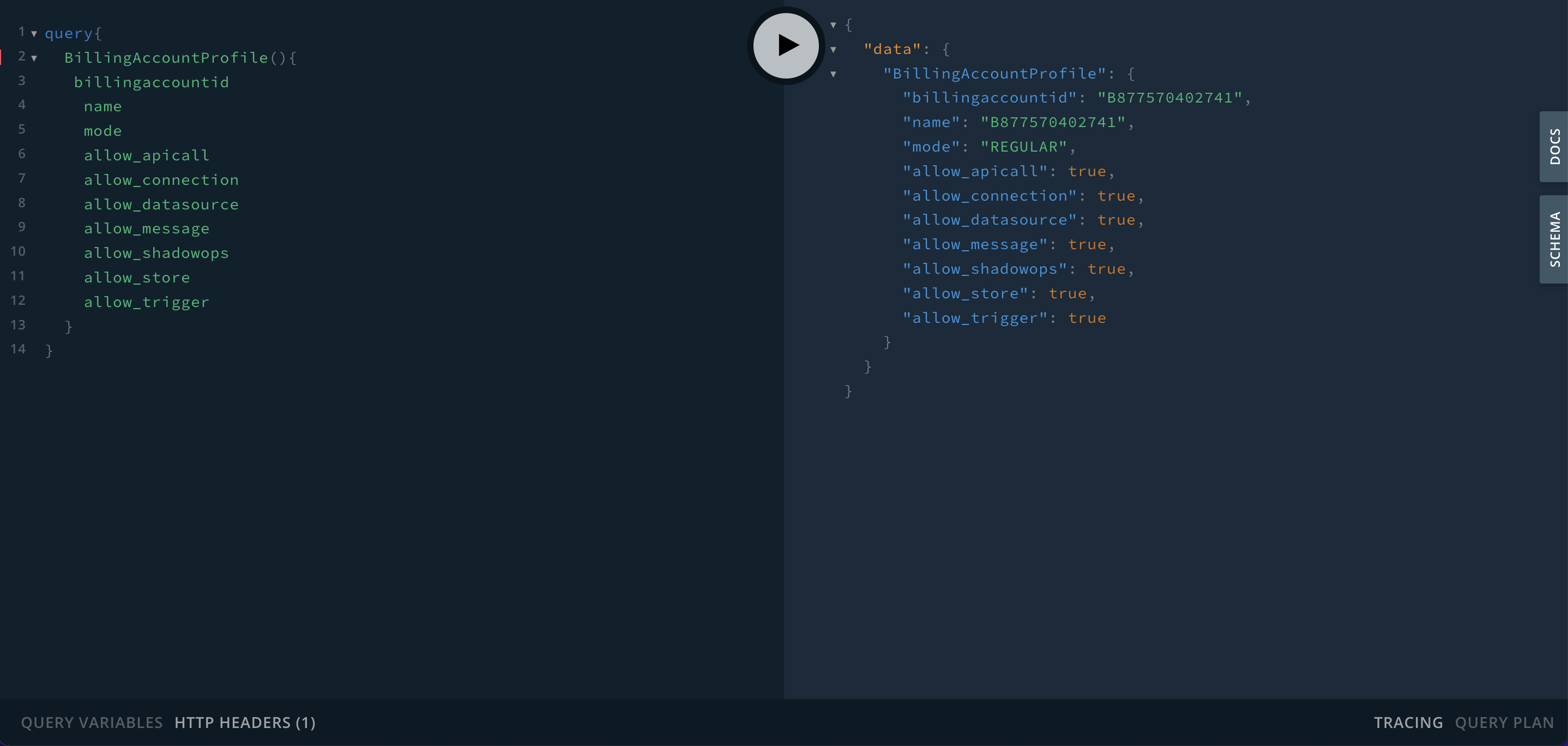
BillingAccountProjectInfo¶
To query the Project list data under that Billing Account ID, the details are as follows:
BillingAccountProjectInfo ( billingaccountid ):
Arguments
billingaccountid: String is the Billing Account ID (required).
Query Variables
Authorization: User Token
Response Type : [ProjectID]
The response is an Array of Object Type ProjectID containing:
projectid: String is the Project ID.
An example is shown in the following figure:
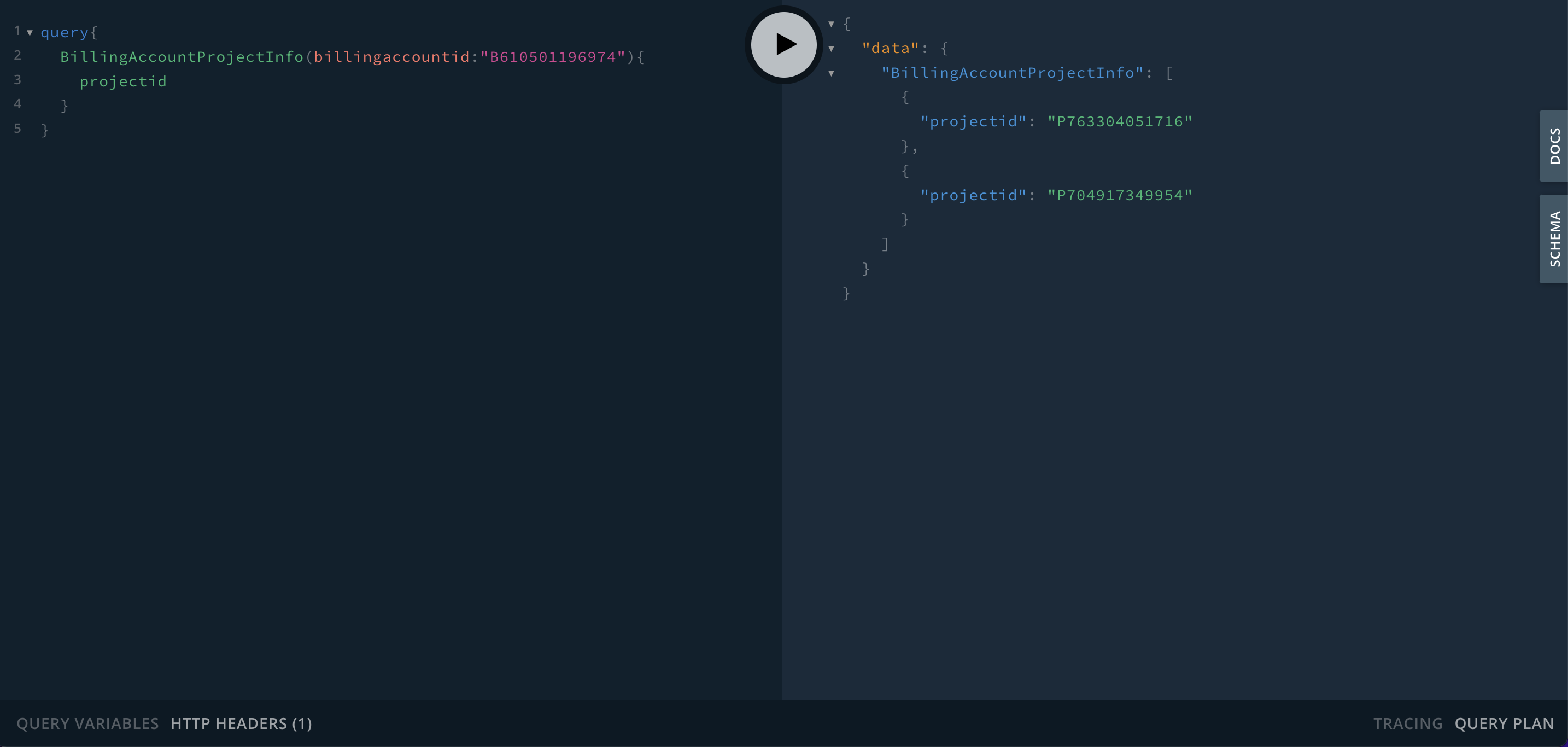
BillingAccountResourceUsageProfile¶
To query the usage limit information and current usage volume of each Billing Account ID, details are as follows:
BillingAccountResourceUsageProfile ( billingaccountid ):
Arguments
billingaccountid: String is the Billing Account ID (required).
Query Variables
Authorization: User Token
Response Type : BillingAccountResourceUsageProfile
The response is an Object Type BillingAccountResourceUsageProfile consisting of:
billingaccountid: String is the Billing Account ID.
max_device_per_billing: Int is the maximum number of devices that can be created in each Billing Account.
max_member_per_project: Int is the maximum number of members that can be invited in each project.
max_project_per_billing: Int is the maximum number of Projects that can be created in each Billing Account.
use_device: Int is the number of devices created in each Billing Account.
use_project: Int is the number of projects created in each Billing Account.
detail: JSON is a usage detail separated by project.
An example is shown in the following figure:
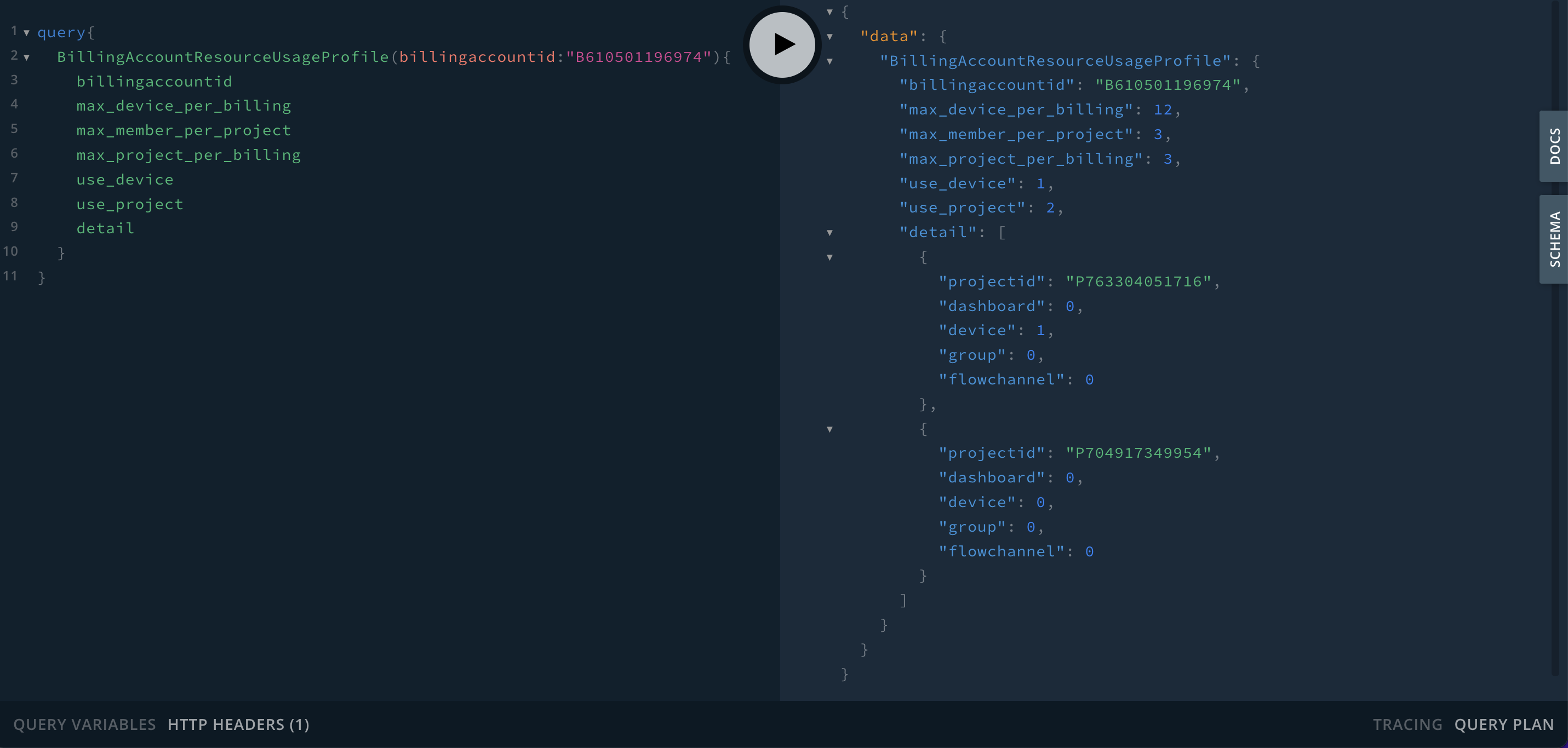
BillingAccountSubscriptionProfile¶
To query the current Subscription Package information of each Billing Account ID, details are as follows:
BillingAccountSubscriptionProfile ( billingaccountid ):
Arguments
billingaccountid: String is the Billing Account ID (required).
Query Variables
Authorization: User Token
Response Type : BillingAccountSubscriptionProfile
ตอบกลับเป็น Object Type BillingAccountSubscriptionProfile ประกอบด้วย
billingaccountid: String is the Billing Account ID.
subscriptionname: String is the name of the Subscription.
billtype: String is the type of billing (PREPAIDorPOSTPAID)
status: String is the activation state (ENABLEDorDISABLED)
packageid: String is the ID of the package to use.
packagename: String is the name of the package to use.
total_cycle: Int is the total number of cycles that can be used.
current_cycle: Int is the number of cycles used so far.
subscription_start_at: String is the date and time the subscription was started.
current_cycle_start_at: String is the start date of the current cycle.
current_cycle_end_at: String is the end date of the current cycle.
max_apicall: Float is the maximum accumulated quota for using API Call in the current billing cycle (unit is Operation).
max_connection: Float is the maximum accumulated time that the Device can be online in the current billing cycle (in seconds).
max_datasource: Float is the maximum accumulated quota for Datasource usage in the current billing cycle (in Bytes).
max_message: Float is the maximum accumulated quota for using Real Time Messages in the current billing cycle (in messages).
max_shadowops: Float is the maximum accumulated quota for Shadow Read/Write usage in the current billing cycle (in Operations).
max_store: Float is the maximum accumulated quota for using Time Series Data Store for the current billing cycle (in Point-Day).
max_trigger: Float is the maximum accumulated quota for using Trigger & Action of the current billing cycle (unit is Operation).
max_device_per_billing: Int is the maximum number of devices that can be created in each Billing Account.
max_member_per_project: Int is the maximum number of members that can be invited in each project.
max_project_per_billing: Int is the maximum number of Projects that can be created in each Billing Account.
note: String is a note.
An example is shown in the following figure:
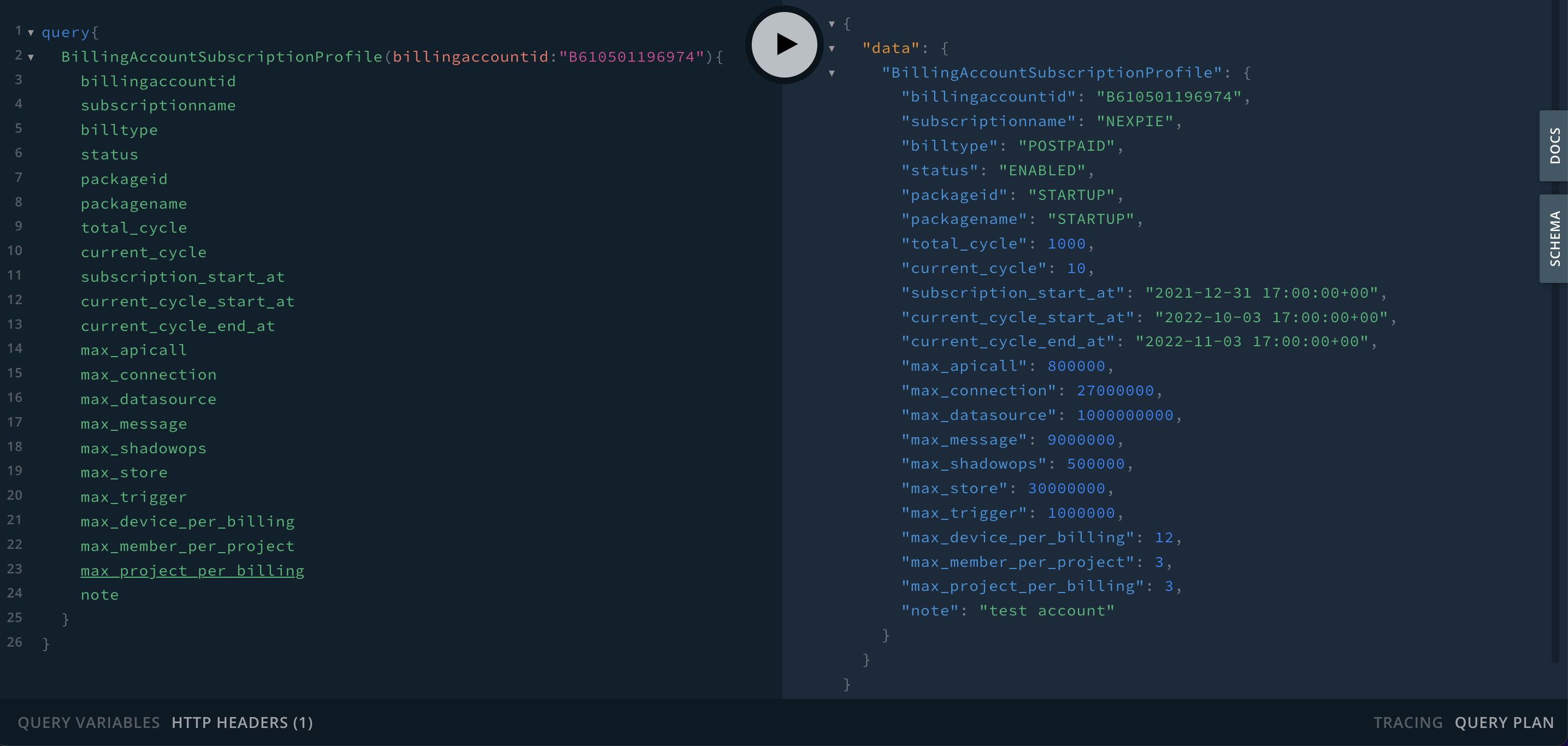
BillingLog¶
To query various Log data items from the system in each Billing Account ID, the details are as follows:
BillingLog ( billingaccountid, begintime, endtime, filter, limit, offset, direction ):
Arguments
billingaccountid: String is the Billing Account ID (required).
begintime: String is the start date of the data generation (required).
endtime: String is the end date of the data generation (required).
filter: BillingLogFilterKey is an Object Type of filter that is used to further specify the search. It consists of:
event: [String] is the name of the event that caused the Log to be generated. Multiple names can be specified.
level: [LogLevel] is the Log notification level. Multiple levels can be specified.
projectid: String is the ID of the project that generated the log.
limit: Int is the limit on the number of data to be extracted.
offset: Int is the sequence of data items to start fetching.
direction: SortDirection is the order of data (ASClowest to highest,DESChighest to lowest).
Query Variables
Authorization: User Token
Response Type : [BillingLog]
The response is an Array of Object Type BillingLog containing:
time: Timestamp is the date and time the Log was generated.
billingaccountid: String is the Billing Account ID.
type: String is a Log type.
level: String is the Log notification level.
event: String is the name of the event that generated the Log.
projects: [String] is an Array of Project ID.
data: JSON is the Log data details.
annotation: String is a description of the Log.
note: String is a note.
An example is shown in the following figure:

BillingMetricUsageProfile¶
To query usage information of various services in the current billing cycle of each Billing Account ID, details are as follows:
BillingMetricUsageProfile ( billingaccountid ):
Arguments
billingaccountid: String is the Billing Account ID (required).
Query Variables
Authorization: User Token
Response Type : BillingMetricUsageProfile
The response is an Object Type BillingMetricUsageProfile consisting of:
billingaccountid: String is the Billing Account ID.
name: String is the name of the Billing Account.
mode: String is the Billing Account mode.
max_apicall: Float is the maximum accumulated quota for using API Call in the current billing cycle (unit is Operation).
max_connection: Float is the maximum accumulated time that the Device can be online in the current billing cycle (in seconds).
max_datasource: Float is the maximum accumulated quota for Datasource usage in the current billing cycle (in Bytes).
max_message: Float is the maximum accumulated quota for using Real Time Messages in the current billing cycle (in messages).
max_shadowops: Float is the maximum accumulated quota for Shadow Read/Write usage in the current billing cycle (in Operations).
max_store: Float is the maximum accumulated quota for using Time Series Data Store for the current billing cycle (in Point-Day).
max_trigger: Float is the maximum accumulated quota for using Trigger & Action of the current billing cycle (unit is Operation).
use_apicall: Float is the amount of quota used in the API Call section of the current billing cycle (in units of Operation).
use_connection: Float is the amount of time the Device has been online in the current billing cycle (in seconds).
use_datasource: Float is the amount of quota used in the Datasource section of the current billing cycle (in Bytes).
use_message: Float is the amount of quota used in the Real Time Message section of the current billing cycle (in messages).
use_shadowops: Float is the amount of quota used in the Shadow Read/Write section of the current billing cycle (in units of Operation).
use_store: Float is the amount of quota used in the Time Series Data Store section of the current billing cycle (in Point-Days).
use_trigger: Float is the amount of quota used in the Trigger & Action section of the current billing cycle (unit is Operation).
usage_begin_at: String is the date and time when the billing cycle starts counting usage.
usage_update_at: String is the date and time the data was last updated.
An example is shown in the following figure:
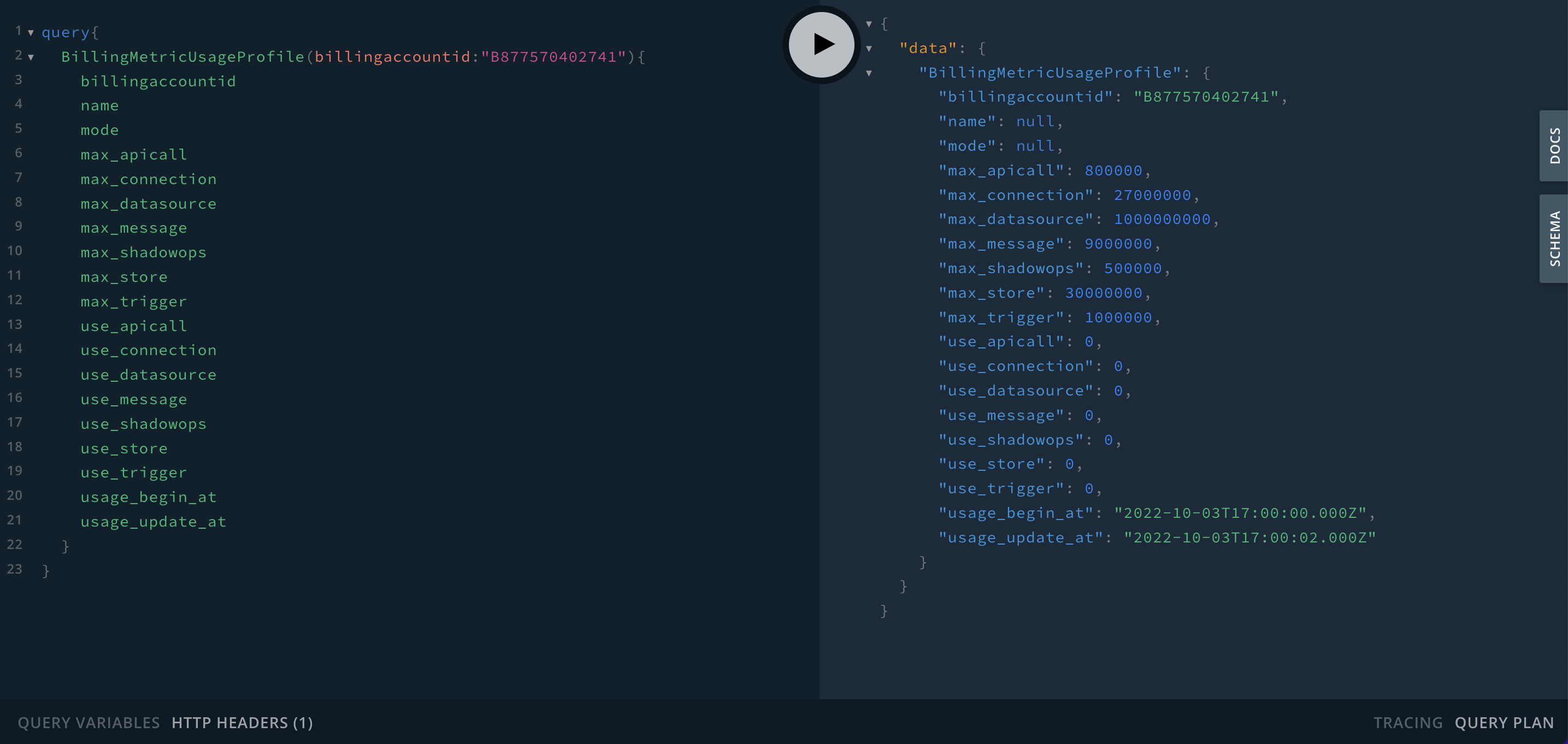
Device¶
To query each Device's information with ID, details are as follows:
device ( deviceid ):
Arguments
deviceid: String is the Device ID (required)
Query Variables
Authorization: User Token
Response Type : Device
The response is Object Type Device consisting of:
alias: String is the name of the Device.
createdtime: Timestamp is the date and time the Device was created.
description: String is a Device description.
deviceid: String คือ is the Device ID.
devicetoken: [String] is a list of all tokens of the Device.
devicesecret: String is the secret code of the Device.
groupid: String is the ID of the Group that the Device is under.
groupname: String is the name of the Group that the Device is under.
projectid: String is the Project ID that the Device is under.
status: Int is Device’s connection status to the platform (0 = offline, 1 = online)
hashtag: [String] is a multi-valued Device tag.
tags: JSON is a Device tag in Key Value format.
enabled: Boolean is the Device activation status (trueenabled [default],falsedisabled).
banned: Boolean is the status of being suspended from the system (truesuspended,falsenot suspended [default]).
credential: Credential is data for verifying identity. Object Type credential consists of:
secret: String is the secret code of the Device.
An example is shown in the following figure:

DeviceList¶
To query the Device data list by various filter types, details are as follows:
deviceList ( fliter, orderBy, direction, limit, offset ):
Arguments
fliter: DeviceFilterKey is the Object Type of the filter used to specify the search. It consists of:
projectid: String is the Project ID that the Device is under (required)
groupid: String is the ID of the Group that the Device is under.
alias: String is the name of the Device.
hashtag: [String] is a multi-valued Device tag.
tags: JSON is a Device tag in Key Value format.
status: Boolean is Device’s connection status to the platform (trueonline,falseoffline)
orderBy: [DeviceSortKey] is a selection of fields that are specified to be sorted by data. It includes:
createdtimeSort by Device Creation Date.
aliasSort by Device Name
deviceidSort by Device ID
statusSort by Device’s connection status to the platform
direction: OrderDirection is an option for the sorting style. It consists of:
ASCOrder from least to most
DESCOrder from most to least
limit: Int is the limit on the number of data to be extracted.
offset: Int is the sequence of data items to start fetching.
Query Variables
Authorization: User Token
Response Type : [Device]
The response is an Array of Object Type Device, consisting of:
alias: String is the name of the Device.
createdtime: Timestamp is the date and time the Device was created.
description: String is a Device description.
deviceid: String is the Device ID.
devicesecret: String is the secret code of the Device.
groupid: String is the ID of the Group that the Device is under.
groupname: String is the name of the Group that the Device is under.
projectid: String is the Project ID that the Device is under.
status: Int is Device’s connection status to the platform (0offline,1online)
hashtag: [String] is a multi-valued Device tag.
tags: JSON is a Device tag in Key Value format.
enabled: Boolean is the Device activation status (trueenabled [default],falsedisabled).
banned: Boolean is the status of being suspended from the system (truesuspended,falsenot suspended [default]).
credential: Credential is data for verifying identity. Object Type credential consists of:
secret: String is the secret code of the Device.
An example is shown in the following figure:
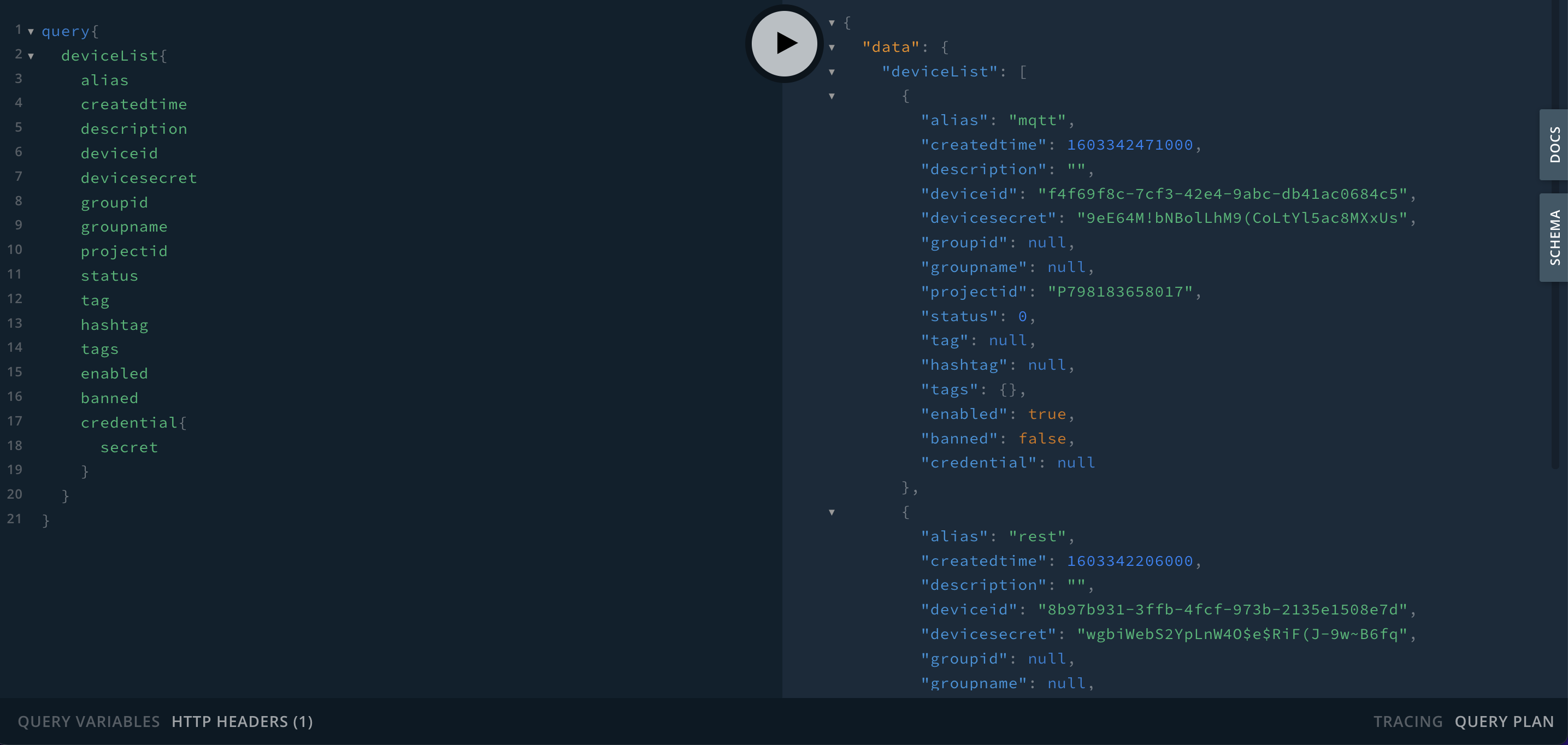
DeviceToken¶
To query the Device Token information, details are as follows:
deviceToken ( deviceid ):
Arguments
deviceid: String is the Device ID (required)
Query Variables
Authorization: User Token
Response Type : DeviceToken
ตอบกลับเป็น Object Type DeviceToken ประกอบด้วย
deviceid: String is the Device ID.
tokencode: String is the Token code.
iat: String is the date and time the token was issued (issued at).
nbf: String is the date when the token will be active (not before).
exp: String is the expiration time of the Token.
expireIn: String is the age of the Token.
An example is shown in the following figure:
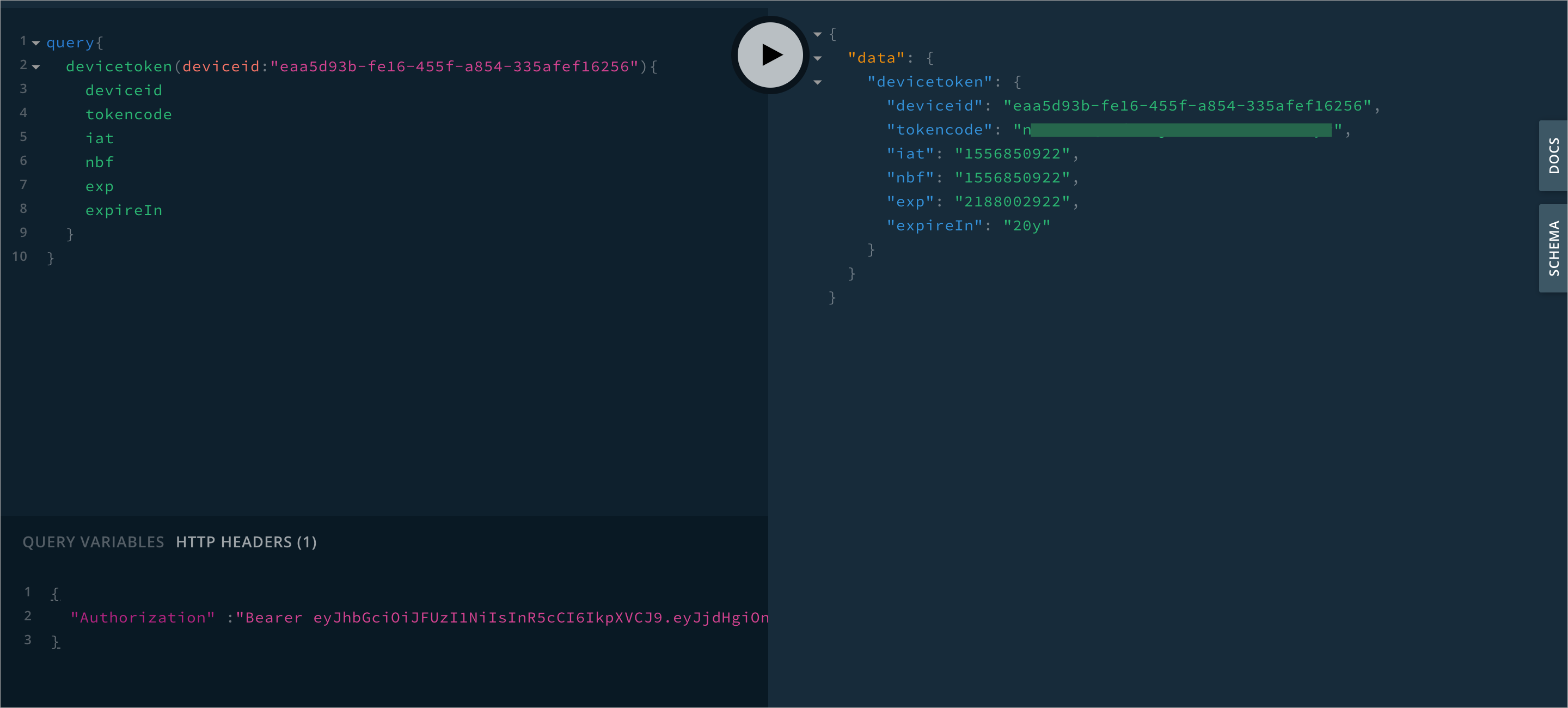
Feed¶
To query the data fields of the Device that are set to store data in the Time Series Data Store (historical data storage), the details are as follows:
feed ( feedid ):
Arguments
feedid: String is the Feed ID which has the same value as deviceid (required).
Query Variables
Authorization: User Token
Response Type : Feed
The response is Object Type Feed consisting of:
feedid: String is the Feed ID.
attributes: JSON is a data field list.
An example is shown in the following figure:
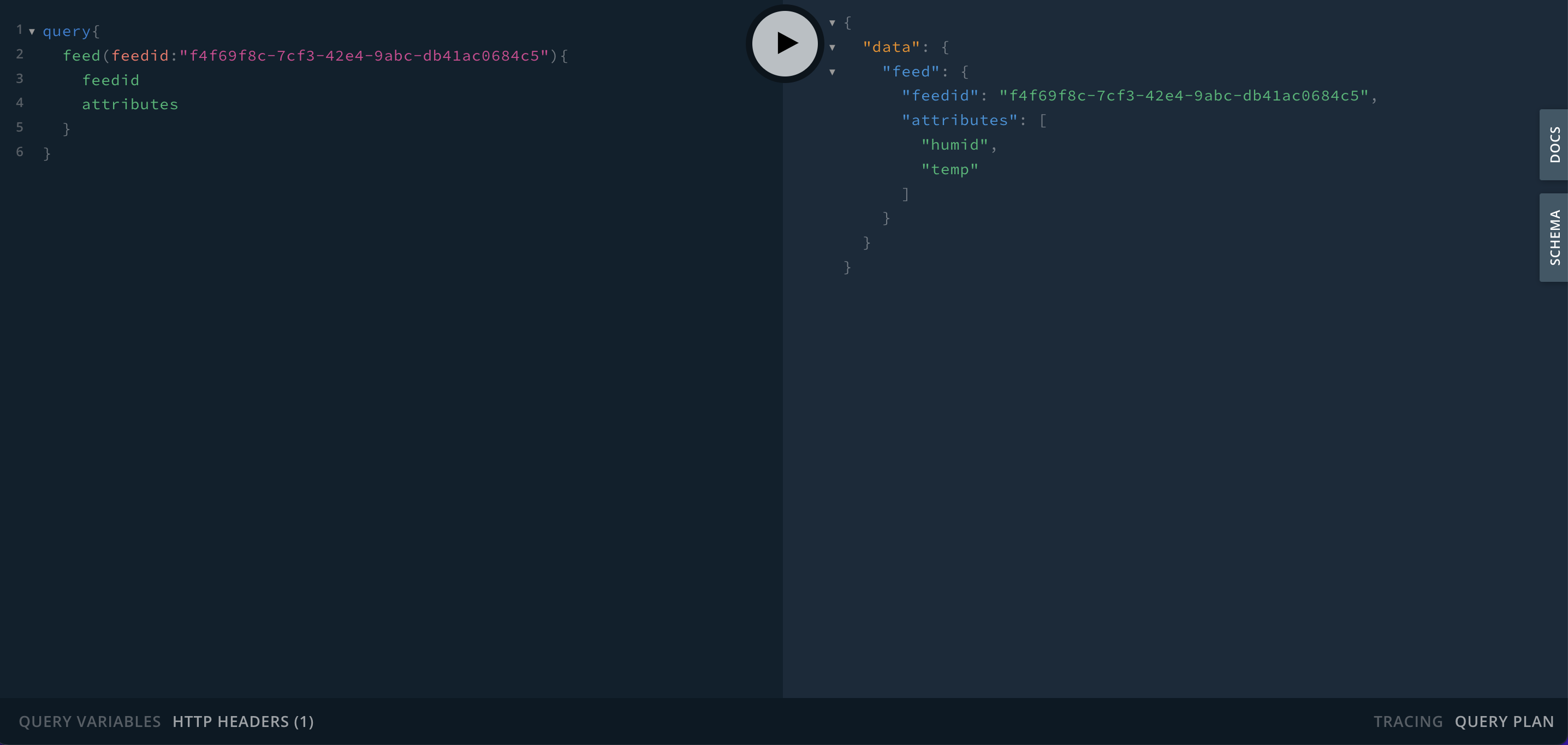
FeedData¶
To query each field of data in the Device Time Series Data Store, the details are as follows:
feedData ( feedid, attributes, starttime, endtime, aggregator, sampling, pointlimit, format ):
Arguments
feedid: String is the Feed ID which has the same value as deviceid (required).
attributes: [String] is the name of the field for which data is to be retrieved (if not specified, all fields will be retrieved).
starttime: Timestamp is the initial time period for which data is required.
endtime: Timestamp is the end time for which data is required.
aggregator: String is a setting that combines or processes data in various forms before returning data points.
sampling: String is the condition for extracting the sample data set.
pointlimit: Int is the limit of the number of data points.
format: DataFormat is the data format to return (JSON(Default),TABLE,CSV).
Query Variables
Authorization: User Token
Response Type : FeedData
The response is Object Type FeedData consisting of:
feedid: String is the Feed ID.
data: JSON is data in each field according to the selected format.
An example is shown in the following figure:
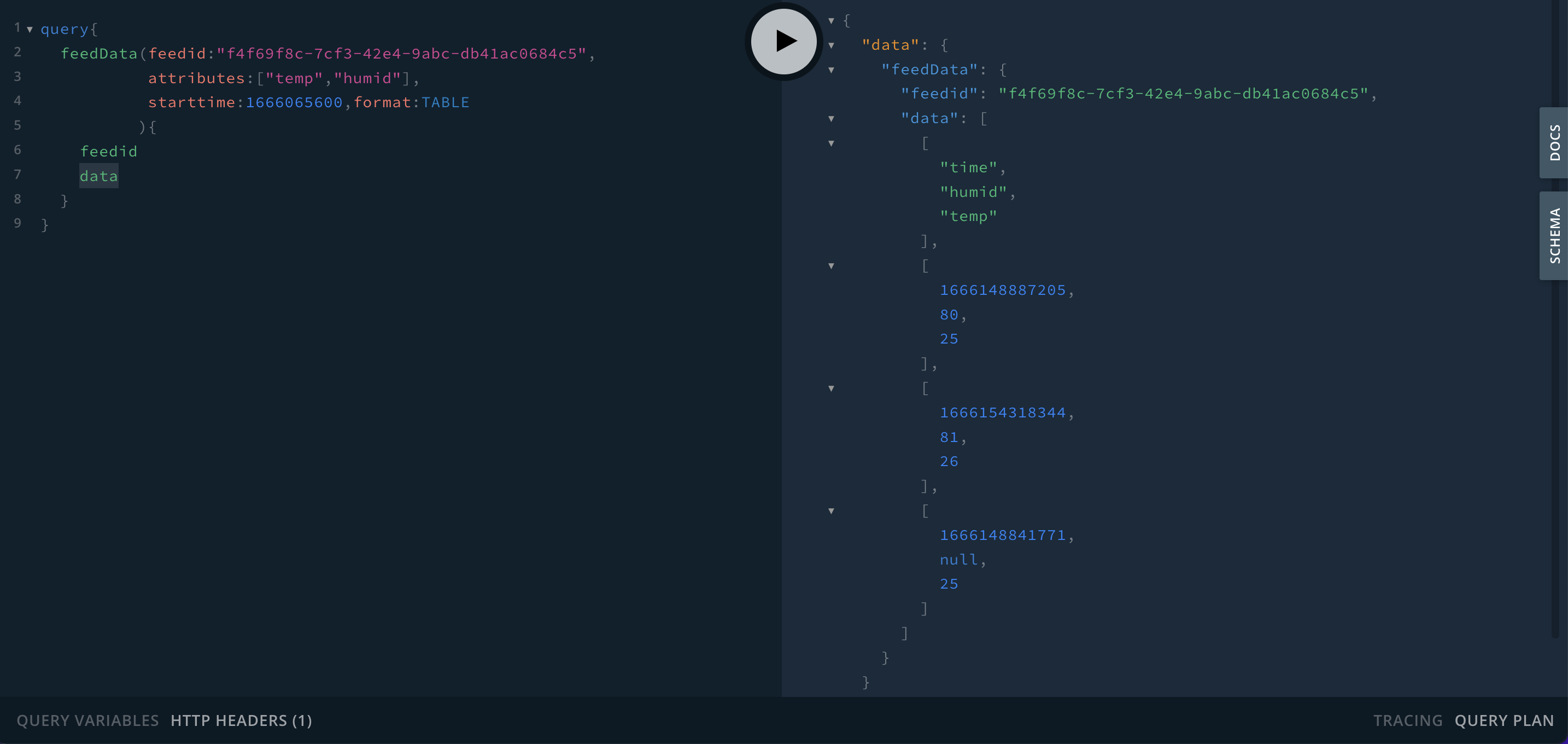
Group¶
To query Group information, each Group has the following ID details:
group ( groupid ):
Arguments
groupid: String is the Group ID (required).
Query Variables
Authorization: User Token
Response Type : Group
The response is an Object Type Group consisting of:
groupid: String is the ID of the Group.
groupname: String is the name of the Group.
projectid: String is the Project ID that the Group is under.
createdtime: Timestamp is the date and time the Group was created.
description: String is a description of the Group.
devicecount: Int is the number of devices under the group.
hashtag: [String] is a multi-valued Group tag.
tags: Json is a Group tag in Key Value format.
An example is shown in the following figure:
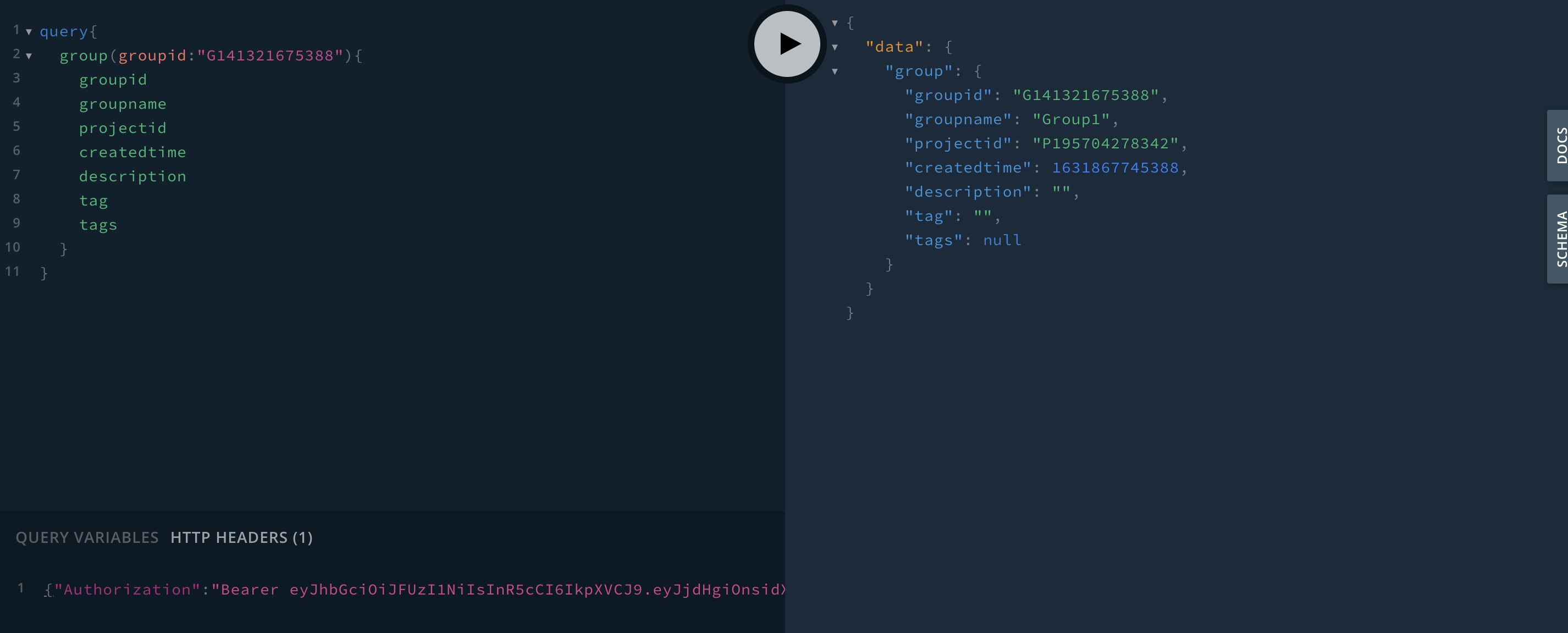
GroupList¶
To query the Group data list by various filter types, details are as follows:
groupList ( fliter, orderBy, direction, limit, offset ):
Arguments
fliter: GroupFilterKey is the Object Type of the filter used to specify the search. It consists of:
projectid: String is the Project ID that the Group is under (required)
groupname: String is the name of the Group.
hashtag: [String] is a multi-valued Group tag.
tags: TagsInput is the Group tag in Key Value format.
orderBy: [GroupSortKey] is a selection of fields that are specified to be sorted by data. It includes:
groupnameSort by Group name
groupidSort by Group ID
createdtimeSort by Device Creation Date
direction: OrderDirection is an option for the sorting style. It consists of:
ASC(Order from least to most)
DESC(Order from most to least)
limit: Int is the limit on the number of data to be extracted.
offset: Int is the sequence of data items to start fetching.
Query Variables
Authorization: User Token
Response Type : [Group]
The response is an Array of Object Type Group consisting of:
groupid: String is the ID of the Group.
groupname: String is the name of the Group.
projectid: String is the Project ID that the Group is under.
createdtime: Timestamp is the date and time the Group was created.
description: String is a description of the Group.
devicecount: Int is the number of devices under the group.
hashtag: [String] is a multi-valued Group tag.
tags: Json is a Group tag in Key Value format.
An example is shown in the following figure:
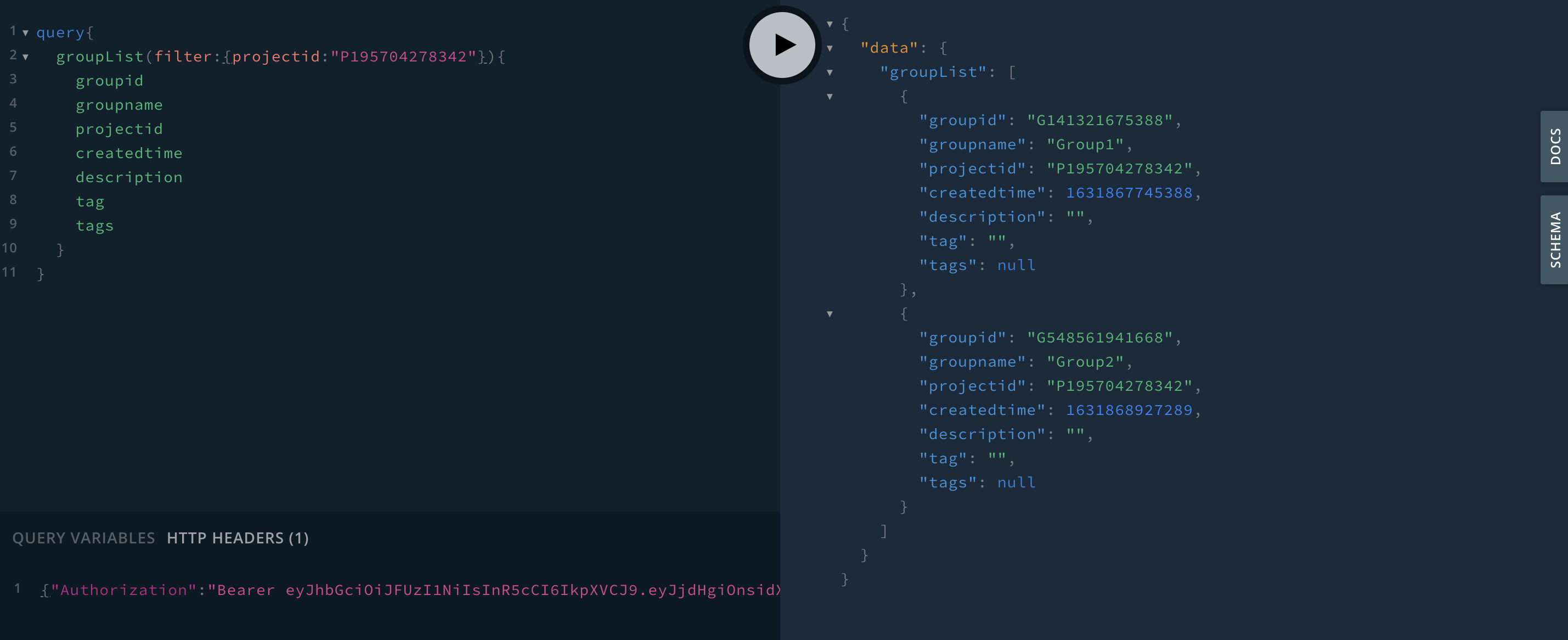
Hook¶
To query the Event Hook data list that has been created according to the specified filters, the details are as follows:
hook ( projectid, hookid ):
Arguments
projectid: String is the Project ID that the Hook is under (required).
hookid: String is the ID of Hook.
Query Variables
Authorization: User Token
Response Type : [Hook]
The response is an Array of Object Type Hook consisting of:
projectid: String is the Project ID that the Group is under.
name: String is the name of the Hook.
hookid: String is the ID of Hook.
description: String is a description of Hook.
type: String is a type of Hook (currently there is only one type, WEBHOOK, so users do not have to choose).
enabled: Boolean is the Hook activation state (trueenabled [default],falsedisabled).
param: Json is a variable that is used to set values to be sent to the destination website.
An example is shown in the following figure:
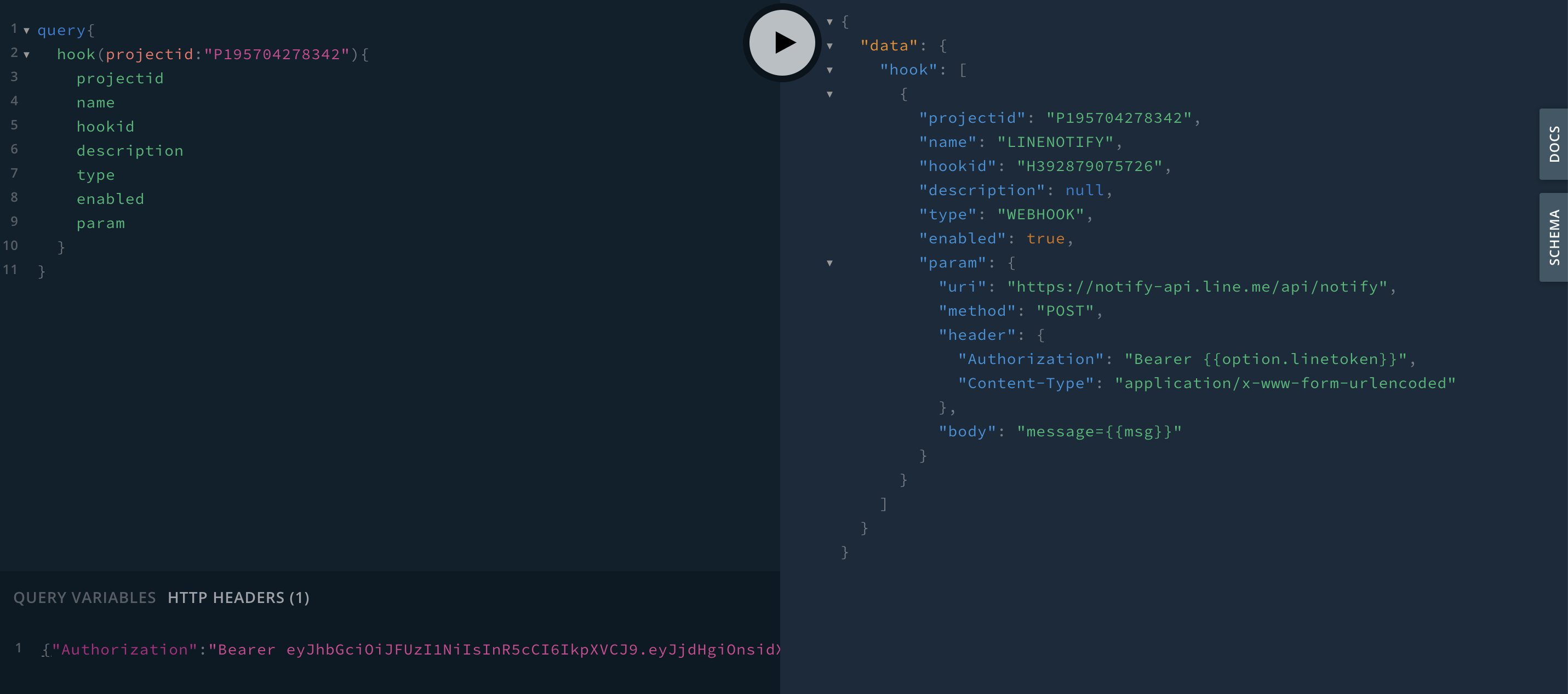
Membership¶
To query member data that has the right to access data in each Project according to the level of permissions received, details as follows:
membership ( projectid ):
Arguments
projectid: String is the Project ID (required)
Query Variables
Authorization: User Token
Response Type : [Membership]
The response is an Array of Object Type Membership consisting of:
createdtime: Timestamp is the date and time the Membership was created.
level: String is the membership privilege level. There are 5 levels in total (see privilege details at Member)
5(Owner)
4(Master)
3(Editor)
2(Viewer)
1(Guest)
projectid: String is the ID of the authorized project.
userid: String is the user ID that is authorized.
username: String is the username of the authorized user.
An example is shown in the following figure:
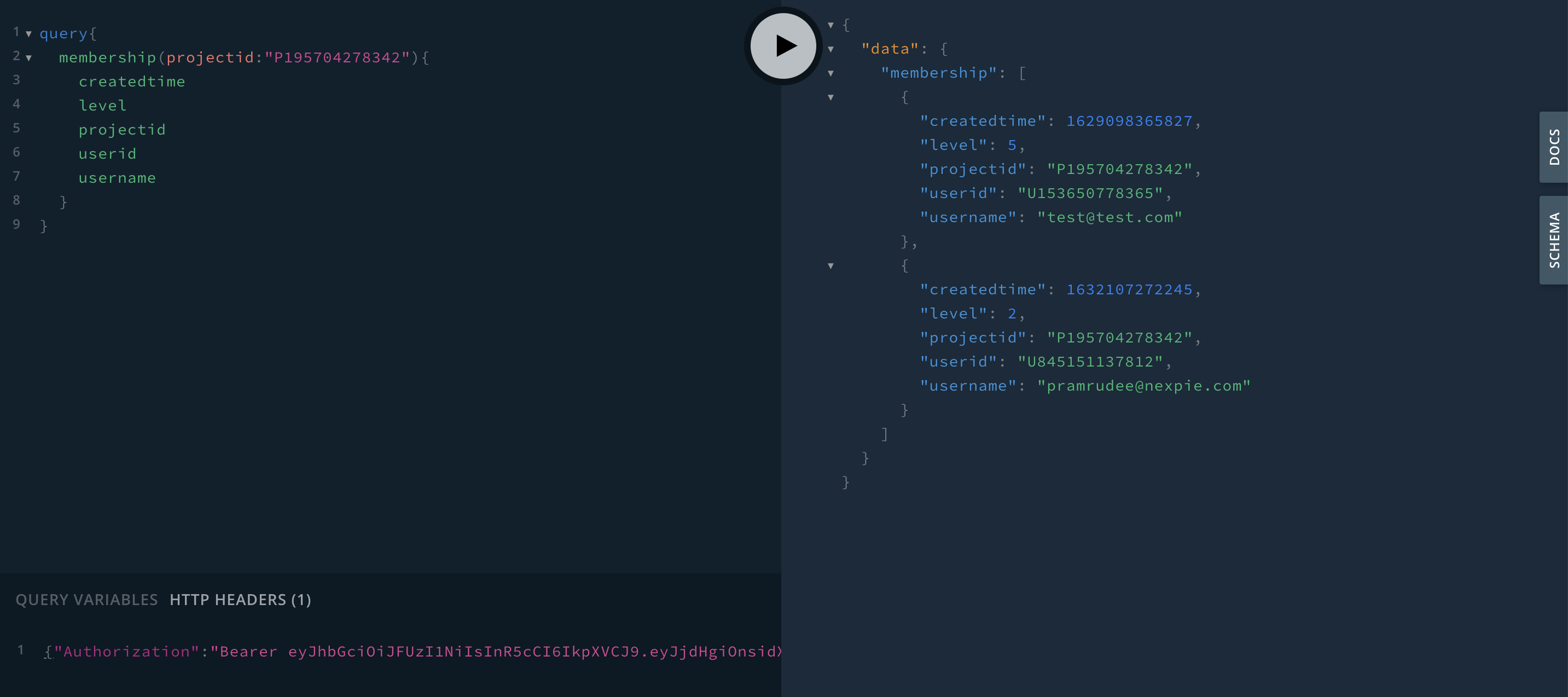
MyBillingAccount¶
To query all Billing Account information of the user who owns the User Token, details are as follows:
MyBillingAccount ():
Arguments
No. The system will check which user it is from the User Token.
Query Variables
Authorization: User Token
Response Type : [BillingMembershipProfile]
The response is an Array of Object Type BillingMembershipProfile containing:
billingaccountid: String is the Billing Account ID.
name: String is the name of the Billing Account.
mode: String is the Billing Account mode.
status: String is the activation state (ENABLEDorDISABLED).
level: Int is the level of access to data. There are 3 levels as follows:
3(Owner)
2(Master)
1(Viewer)
An example is shown in the following figure:
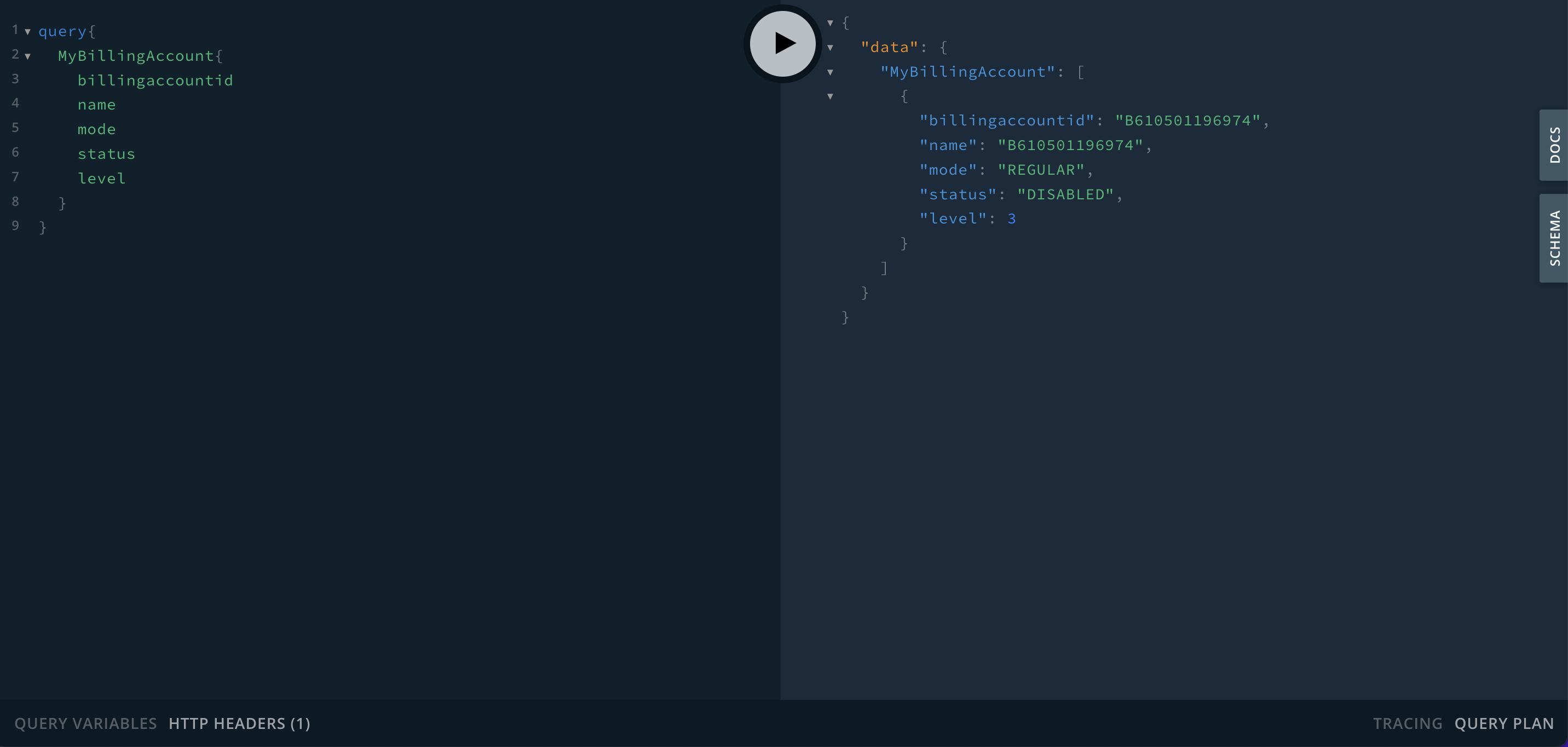
Project¶
To query Project data with the following ID details:
project ( projectid ):
Arguments (one or more required)
projectid: String is the Project ID (required)
Query Variables
Authorization: User Token
Response Type : Project
The response is Object Type Project consisting of:
projectname: String is the name of the Project.
projectid: String is the Project ID.
createdtime: Timestamp is the date and time the project was created.
description: String is a project description.
tags: JSON is a project tag in Key Value format.
hashtag: [String] is a multi-valued Project tag.
numberdevice: Int is the number of devices under the project.
numbergroup: Int is the number of Groups under the Project.
numberdeviceonline: Int is the number of devices currently connected to the Platform under the Project.
numberdeviceoffline: Int Number of Devices currently not connected to the Platform under the Project.
quota: Quota is the status of each service with available quota, which includes:
apicall: Boolean is a REST API service (trueavailable quota,falseunavailable or no quota)
connection: Boolean คือ บริการเชื่อมต่อ Platform ของ Device (trueavailable quota,falseunavailable or no quota).
message: Boolean is a Real Time Message service via MQTT Protocol (trueavailable quota,falseunavailable or no quota).
shadowops: Boolean is a Shadow read/write service (trueavailable quota,falseunavailable or no quota)
store: Boolean is a service that stores data in Time Series Data (trueavailable quota,falseunavailable or no quota)
trigger: Boolean is Trigger & Action (Notification) service (trueavailable quota,falseunavailable or no quota)
datasource: Boolean is the sum of the Byte size of the data that has been used by theapicallservice (trueavailable quota,falseunavailable or no quota)
An example is shown in the following figure:
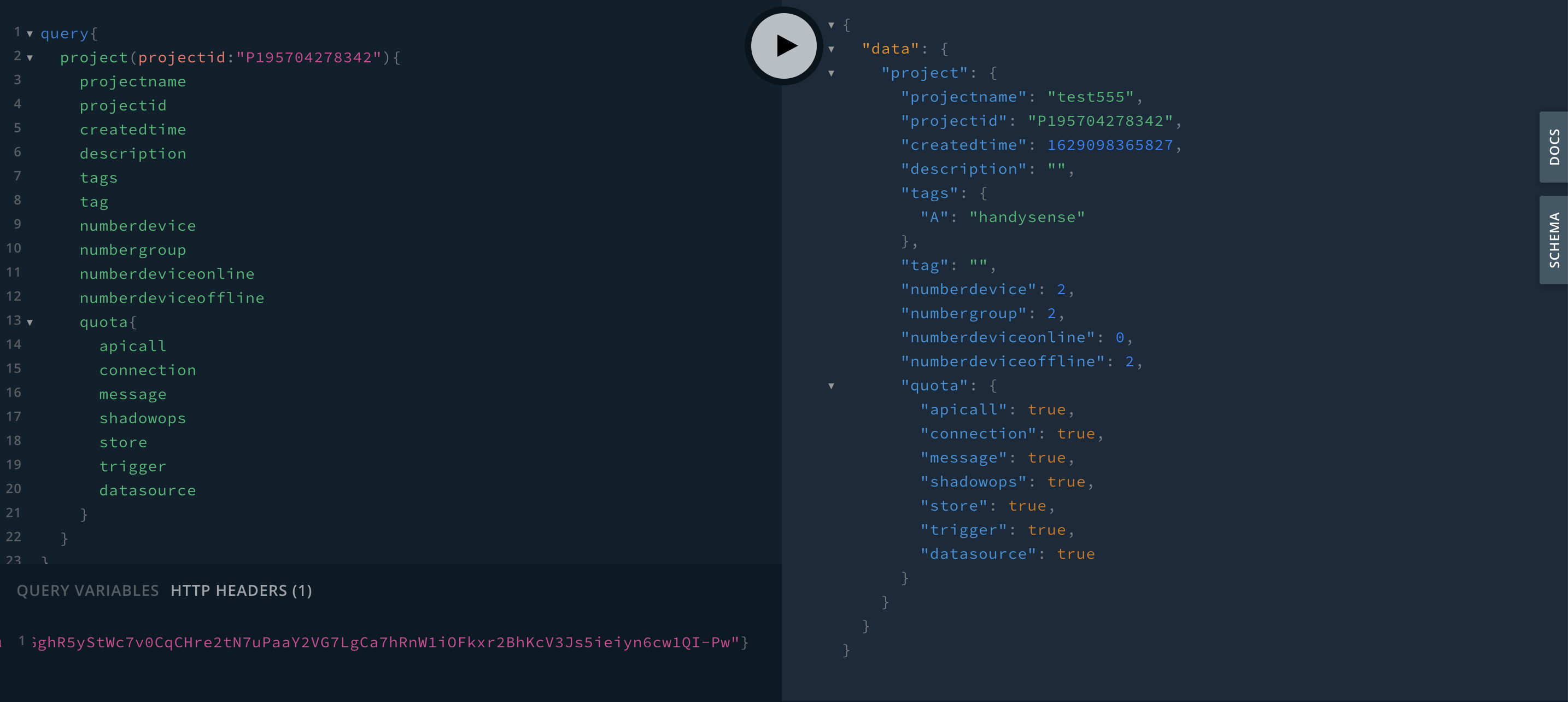
ProjectBillingAccountInfo¶
To query the Billing Account information of each Project, details are as follows:
ProjectBillingAccountInfo ( projectid ):
Arguments
projectid: String is the Project ID (required)
Query Variables
Authorization: User Token
Response Type : BillingAccountProfile
The response is an Object Type BillingAccountProfile consisting of:
billingaccountid: String is the Billing Account ID.
name: String is the name of the Billing Account.
mode: String is the Billing Account mode.
allow_apicall: Boolean is indicator whetherAPI Callare permitted (truefor allowed,falsefor not allowed).
allow_connection: Boolean is indicator whether Connecting a device to the platform are permitted (truefor allowed,falsefor not allowed).
allow_datasource: Boolean is indicator whetherDatasourceare permitted (truefor allowed,falsefor not allowed).
allow_message: Boolean is indicator whetherReal Time Messageare permitted (truefor allowed,falsefor not allowed).
allow_shadowops: Boolean is indicator whetherShadow Read/Write(truefor allowed,falsefor not allowed).
allow_store: Boolean is indicator whetherTime Series Data Storeare permitted (truefor allowed,falsefor not allowed).
allow_trigger: Boolean is indicator whetherTrigger & Actionare permitted (truefor allowed,falsefor not allowed).
An example is shown in the following figure:
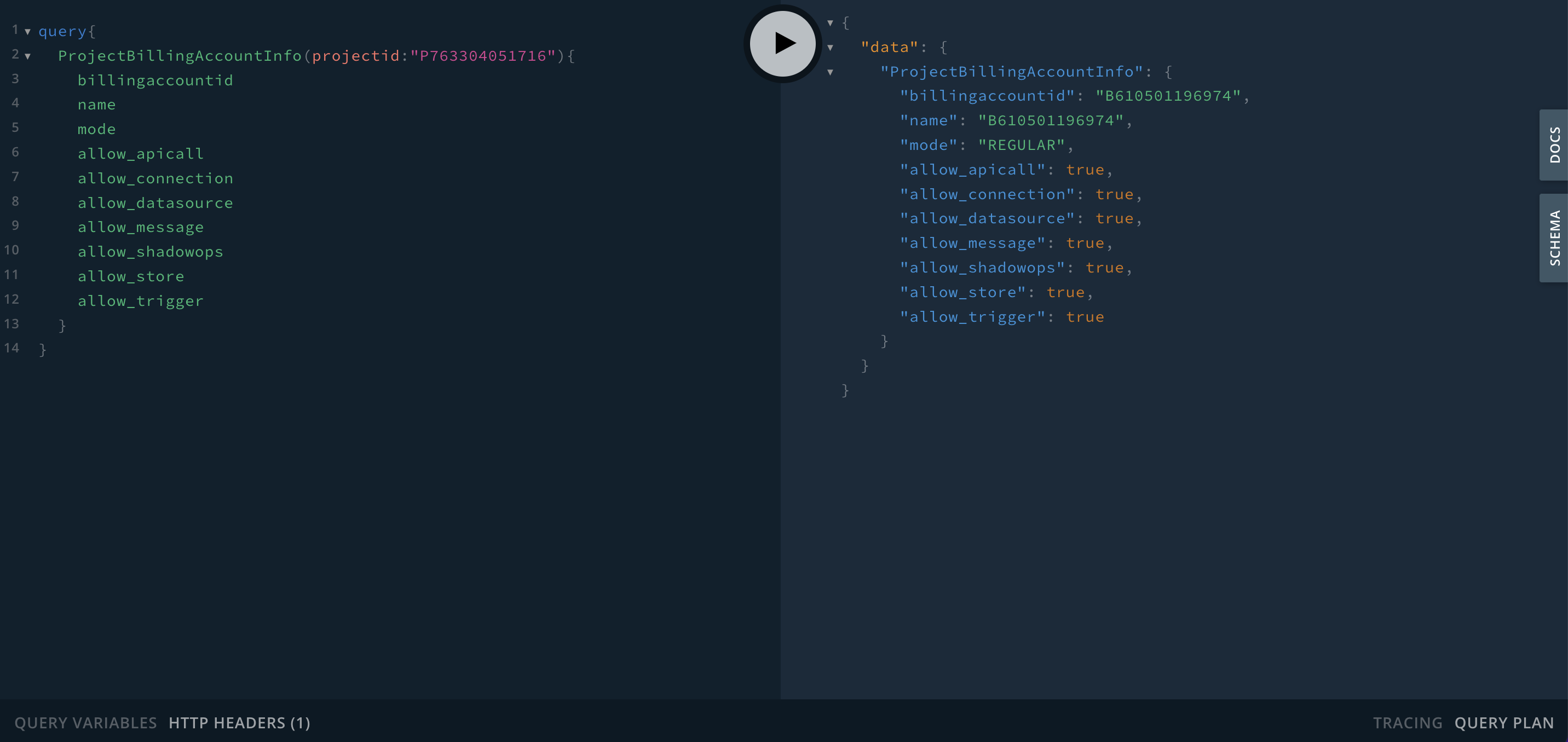
ProjectBillingAccountSubscriptionProfile¶
To access the current Subscription Package information for each Project, details are as follows:
- ProjectBillingAccountSubscriptionProfile ( projectid ):
Arguments
projectid: String is the Project ID (required)
Query Variables
Authorization: User Token
Response Type : BillingAccountSubscriptionProfile
The response is an Object Type BillingAccountSubscriptionProfile consisting of:
billingaccountid: String is the Billing Account ID.
subscriptionname: String is the name of the Subscription.
billtype: String is the type of billing (PREPAIDorPOSTPAID).
status: String is the activation state (ENABLEDorDISABLED).
packageid: String is the code of the package to use.
packagename: String is the name of the package to use.
total_cycle: Int is the total number of cycles that can be used.
current_cycle: Int is the number of cycles used so far.
subscription_start_at: String is the date and time the subscription was started.
current_cycle_start_at: String is the start date of the current cycle.
current_cycle_end_at: String is the end date of the current cycle.
max_apicall: Float is the maximum accumulated quota for using API Call in the current billing cycle (unit is Operation).
max_connection: Float is the maximum accumulated time that the Device can be online in the current billing cycle (in seconds).
max_datasource: Float is the maximum accumulated quota for Datasource usage in the current billing cycle (in Bytes).
max_message: Float is the maximum accumulated quota for using Real Time Messages in the current billing cycle (in messages).
max_shadowops: Float is the maximum accumulated quota for Shadow Read/Write usage in the current billing cycle (in Operations).
max_store: Float is the maximum accumulated quota for using Time Series Data Store for the current billing cycle (in Point-Day).
max_trigger: Float is the maximum accumulated quota for using Trigger & Action of the current billing cycle (unit is Operation).
max_device_per_billing: Int is the maximum number of devices that can be created in each Billing Account.
max_member_per_project: Int is the maximum number of members that can be invited in each project.
max_project_per_billing: Int is the maximum number of Projects that can be created in each Billing Account.
note: String is a note.
An example is shown in the following figure:
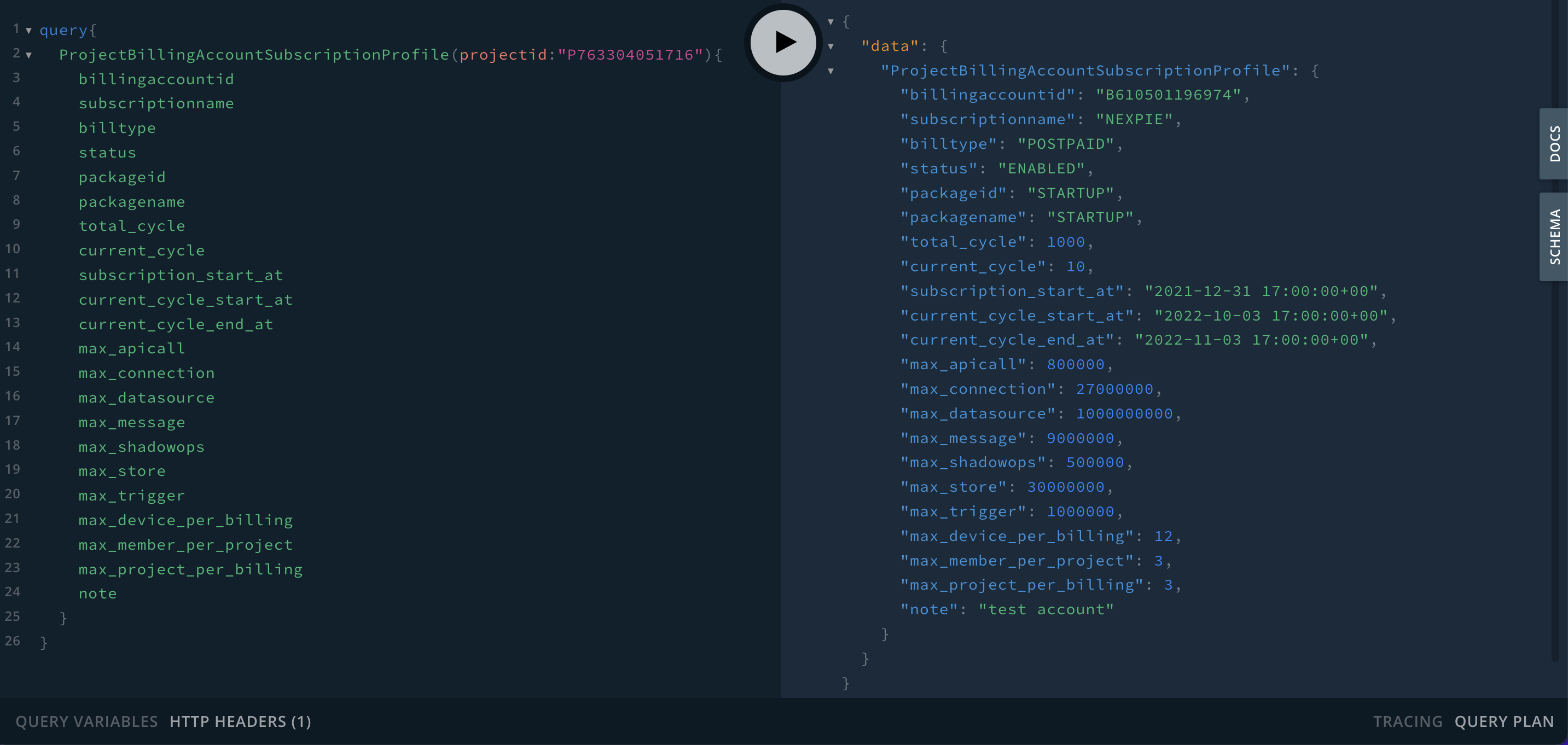
ProjectBillingMetricUsageProfile¶
To query usage information of various services in the current billing cycle of each project, details are as follows:
ProjectBillingMetricUsageProfile ( projectid ):
Arguments
projectid: String is the Project ID (required)
Query Variables
Authorization: User Token
Response Type : BillingMetricUsageProfile
ตอบกลับเป็น Object Type BillingMetricUsageProfile ประกอบด้วย
billingaccountid: String is the Billing Account ID.
name: String is the name of the Billing Account.
mode: String is the Billing Account mode.
max_apicall: Float is the maximum accumulated quota for using API Call in the current billing cycle (unit is Operation).
max_connection: Float is the maximum accumulated time that the Device can be online in the current billing cycle (in seconds).
max_datasource: Float is the maximum accumulated quota for Datasource usage in the current billing cycle (in Bytes).
max_message: Float is the maximum accumulated quota for using Real Time Messages in the current billing cycle (in messages).
max_shadowops: Float is the maximum accumulated quota for Shadow Read/Write usage in the current billing cycle (in Operations).
max_store: Float is the maximum accumulated quota for using Time Series Data Store for the current billing cycle (in Point-Day).
max_trigger: Float is the maximum accumulated quota for using Trigger & Action of the current billing cycle (unit is Operation).
use_apicall: Float is the amount of quota used in the API Call section of the current billing cycle (in units of Operation).
use_connection: Float is the amount of time the Device has been online in the current billing cycle (in seconds).
use_datasource: Float is the amount of quota used in the Datasource section of the current billing cycle (in Bytes).
use_message: Float is the amount of quota used in the Real Time Message section of the current billing cycle (in messages).
use_shadowops: Float is the amount of quota used in the Shadow Read/Write section of the current billing cycle (in units of Operation).
use_store: Float is the amount of quota used in the Time Series Data Store section of the current billing cycle (in Point-Days).
use_trigger: Float is the amount of quota used in the Trigger & Action section of the current billing cycle (unit is Operation).
usage_begin_at: String is the date and time when the billing cycle starts counting usage.
usage_update_at: String is the date and time the data was last updated.
An example is shown in the following figure:
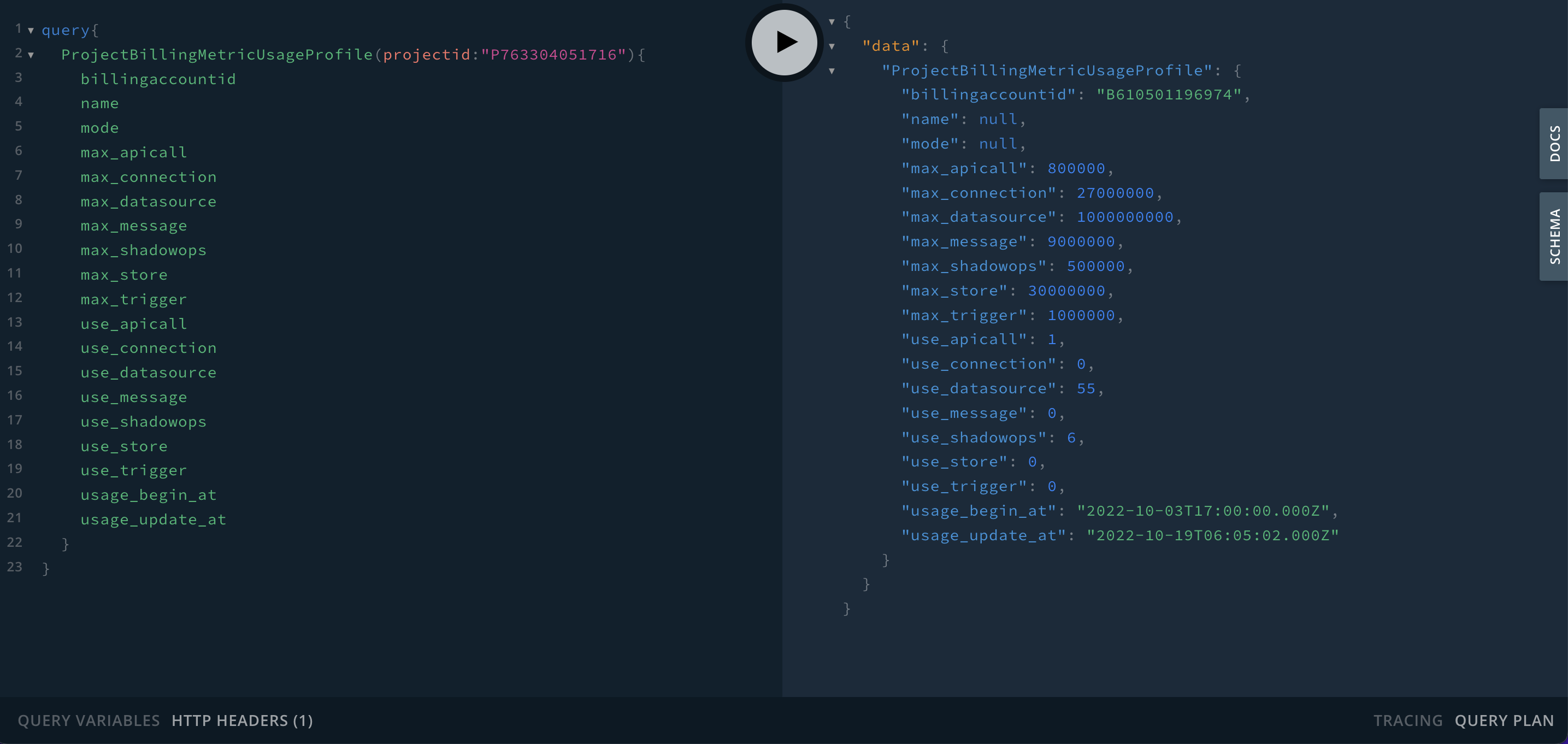
ProjectList¶
To query Project data with the following ID details:
projectList ( fliter, orderBy, direction, limit, offset ):
Arguments
fliter: ProjectPFilterKey is the Object Type of the filter used to specify the search. It consists of:
projectname: String is the name of the Project.
hashtag: [String] is a multi-valued Project tag.
tags: JSON is a project tag in Key Value format.
orderBy: [ProjectSortKey] is a selection of fields that specify the sorting key, including:
projectid(Sort by Project ID)
projectname(Sort by Project name)
createdtime(Sort by project creation date)
direction: OrderDirection is an option for the sorting style. It consists of:
ASC(Order from least to most)
DESC(Order from most to least)
limit: Int is the limit on the number of data to be extracted.
offset: Int is the sequence of data items to start fetching.
Query Variables
Authorization: User Token
Response Type : [Project]
The response is an Array of Object Type Project consisting of:
projectname: String is the name of the Project.
projectid: String is the Project ID.
description: String is a project description.
userlevel: String is the Project data access level.
createdtime: Timestamp is the date and time the project was created.
tags: Json is a project tag in Key Value format.
hashtag: [String] is a multi-valued Project tag.
numberdevice: Int is the number of devices under the project.
numbergroup: Int is the number of Groups under the Project.
numberdeviceonline: Int is the number of devices currently connected to the Platform under the Project.
numberdeviceoffline: Int is the number of Devices currently not connected to the Platform under the Project.
quota: Quota is the status of each service with available quota, which includes:
apicall: Boolean is a REST API service (trueavailable quota,falseunavailable or no quota)
connection: Boolean คือ บริการเชื่อมต่อ Platform ของ Device (trueavailable quota,falseunavailable or no quota).
message: Boolean is a Real Time Message service via MQTT Protocol (trueavailable quota,falseunavailable or no quota).
shadowops: Boolean is a Shadow read/write service (trueavailable quota,falseunavailable or no quota)
store: Boolean is a service that stores data in Time Series Data (trueavailable quota,falseunavailable or no quota)
trigger: Boolean is Trigger & Action (Notification) service (trueavailable quota,falseunavailable or no quota)
datasource: Boolean is the sum of the Byte size of the data that has been used by theapicallservice (trueavailable quota,falseunavailable or no quota)
An example is shown in the following figure:
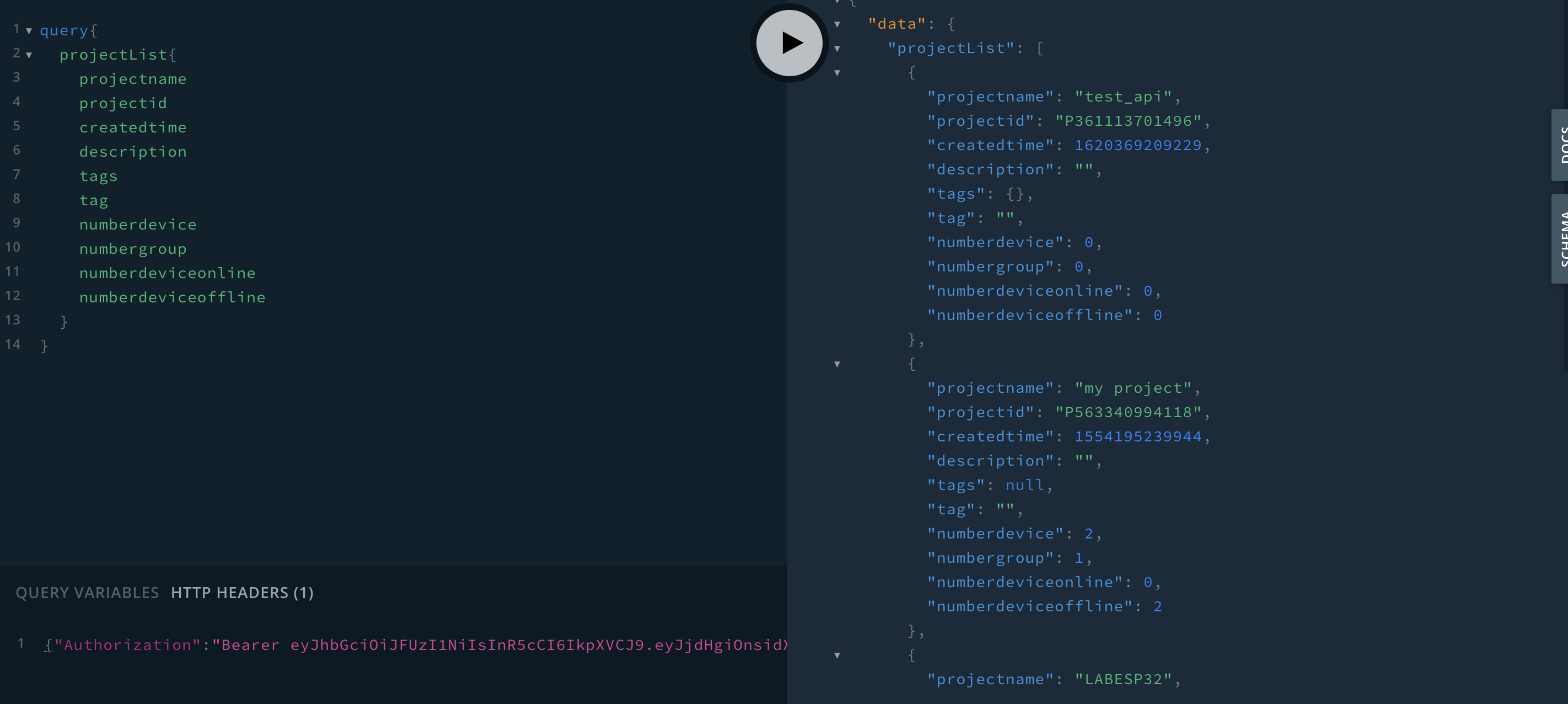
Schema¶
To query the Device Shadow Schema information, details are as follows:
schema ( deviceid ):
Arguments
deviceid: String is the Device ID (required)
Query Variables
Authorization: User Token
Response Type : Schema
The response is an Object Type Schema consisting of:
deviceid: String is the Device ID.
value: JSON is a defined Shadow Schema, which is in JSON format.
An example is shown in the following figure:
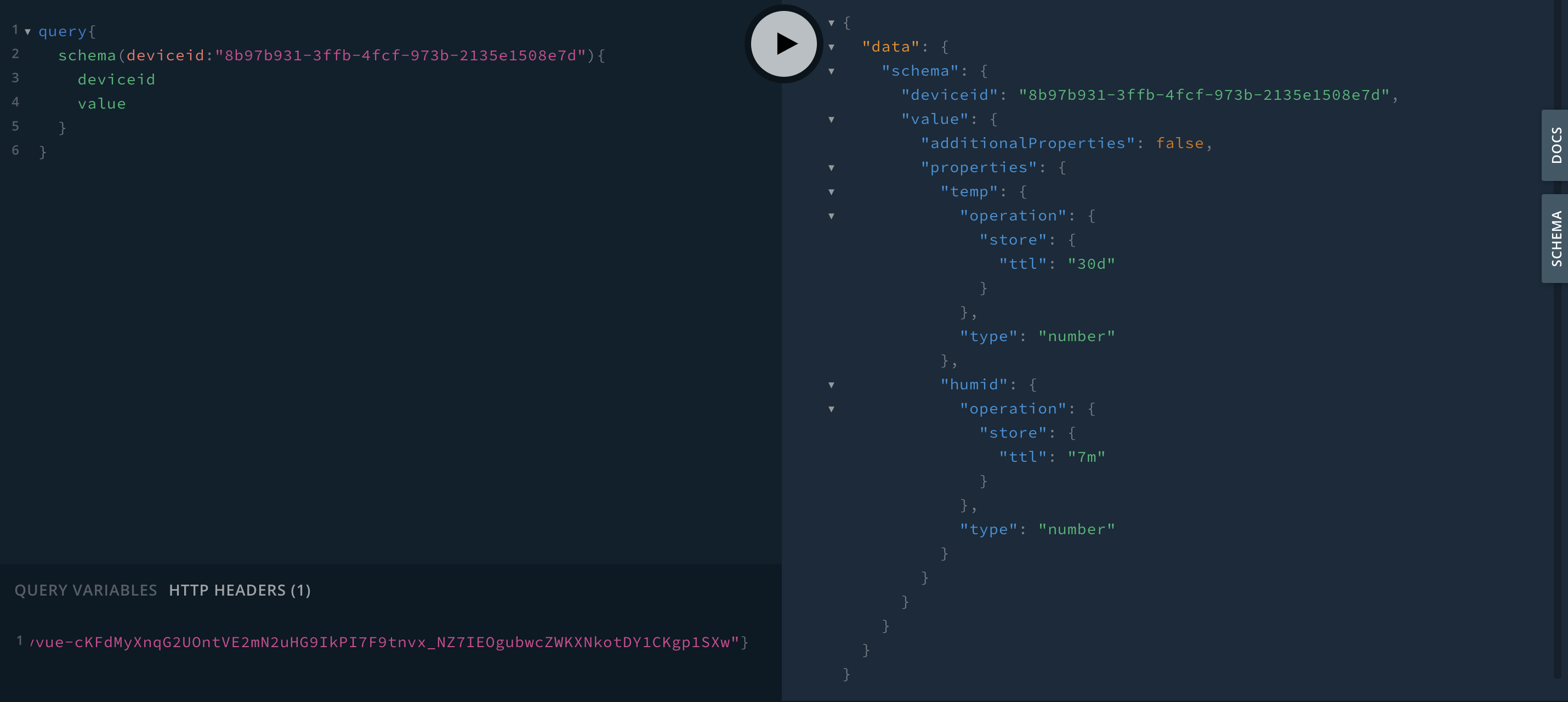
Shadow¶
To query the Device Shadow data, the details are as follows:
shadow ( deviceid ):
Arguments
deviceid: String is the Device ID (required)
command: Command is an Object Type Command that consists of the following:
value: String is the Shadow structure that you want to query the value (in case you want some data in the Shadow).
Query Variables
Authorization: User Token
Response Type : Shadow
The response is Object Type Shadow consisting of:
deviceid: String is the Device ID.
data: JSON is the defined Shadow, which will be in JSON format.
rev: Int is the Revision number.
modified: Timestamp is the date and time the data was last modified.
An example is shown in the following figure:
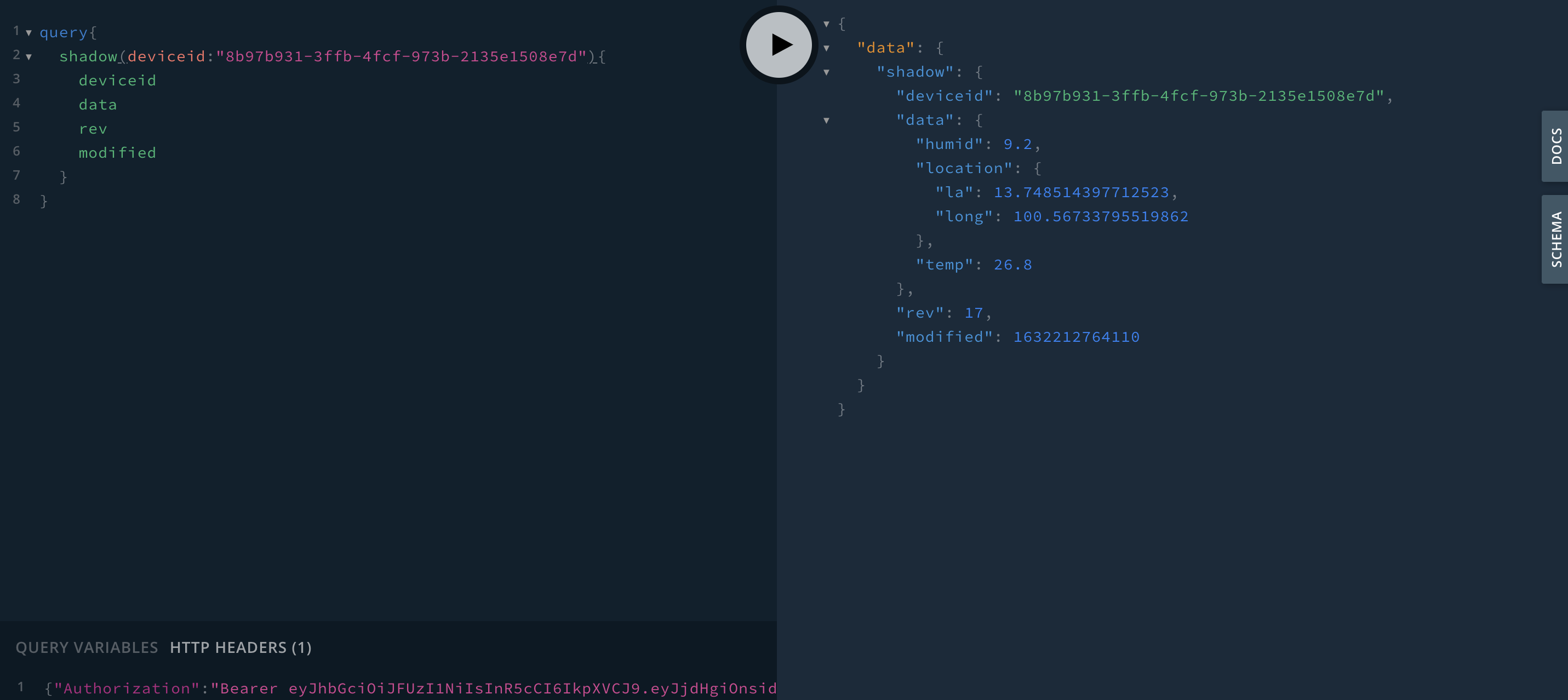
Trigger¶
To query Device Trigger information, details are as follows:
trigger ( deviceid, triggerid, type ):
Arguments
deviceid: String is the Device ID (required)
triggerid: String is the Trigger ID.
type: String คือ is of Trigger type (DEVICE,SHADOW)
Query Variables
Authorization: User Token
Response Type : Trigger
The response is an Object Type Trigger consisting of:
triggerid: String is the Trigger ID.
triggername: String is the name of the Trigger.
type: String is of Trigger type (DEVICE,SHADOW)
event: String is the event that triggers (STATUSCHANGEDpaired with Trigger typeDEVICE,UPDATEDpaired with Trigger typeSHADOW).
condition: String is the trigger condition.
action: String is an Event Hook that will be processed when the Trigger occurs.
context: [ActionVarType] is a Key-Value variable that will send values for use in the Event Hook.
enabled: Boolean is the activation state (trueenabled,falsedisabled).
An example is shown in the following figure:

UserByUserID¶
To query User data with ID details as follows:
:userByUserID ( userid ):
Arguments
userid: String is the User ID (required)
Query Variables
Authorization: User Token
Response Type : Trigger
The response is an Object Type Trigger consisting of:
username: String is the username.
enail: String is the user email.
profile: Profile is an Object Type Profile consisting of:
fullname: String is the first and last name.
phonenumber: String is a phone number.
organization: String is the name of the department/organization/company that belongs to.
created: String is the date and time of registration.
userid: String is the User ID.
option: Option is User type (oneidID from OneID system)
An example is shown in the following figure:
